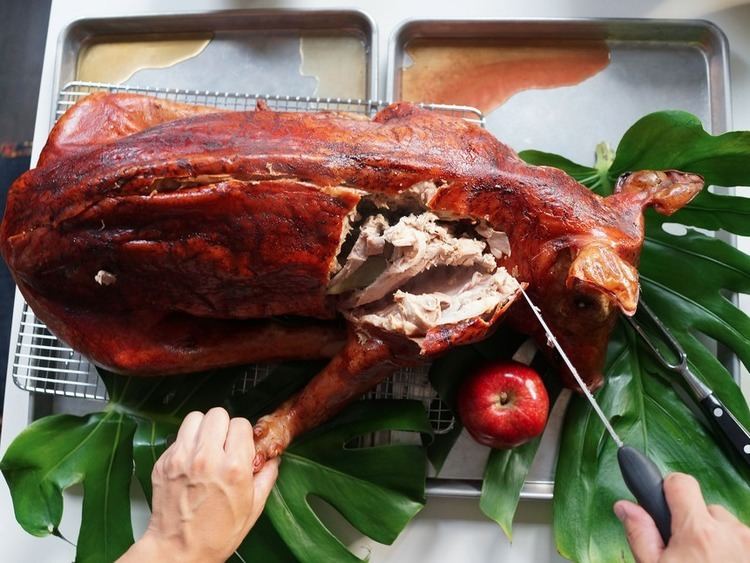 | ||
Similar | ||
Matt tebbutt s roasted suckling pig with beetroot potatoes
A suckling pig (or sucking pig) is a piglet fed on its mother's milk (i.e., a piglet which is still a "suckling"). In culinary contexts, a suckling pig is slaughtered between the ages of two and six weeks. It is traditionally cooked whole, often roasted, in various cuisines. It is usually prepared for special occasions and gatherings.
Contents
- Matt tebbutt s roasted suckling pig with beetroot potatoes
- History
- Regional dishes
- Spanish speaking countries Lechn
- Asia
- European
- United States
- References
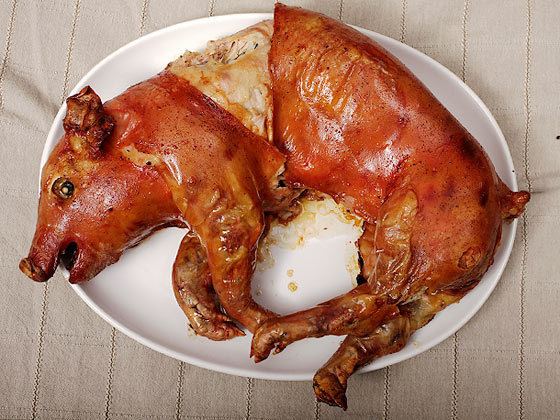
The meat from suckling pig is pale and tender and the cooked skin is crisp and can be used for pork rinds. The texture of the meat can be somewhat gelatinous due to the amount of collagen in a young pig.

History
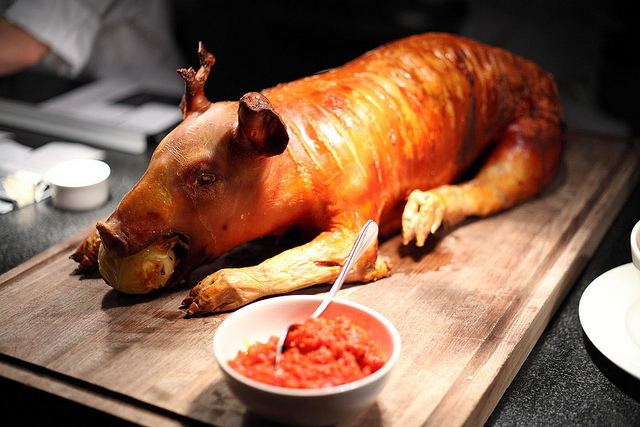
There are many ancient recipes for suckling pig from Roman and Chinese cuisine. Since the pig is one of the first animals domesticated by human beings for slaughter, many references to pigs are found in human culture. The suckling pig, specifically, appears in early texts such as the sixth-century Salic law. As an example of a law governing the punishment for theft, Title 2, article 1, is, in Latin, Si quis porcellum lactantem furaverit, et ei fuerit adprobatum (malb. chrane calcium hoc est) CXX dinarios qui faciunt solidos III culpabilis iudicetur. "If someone has stolen a suckling pig and this is proven against him, the guilty party will be sentenced to 120 denarii which adds up to three solidus (Latin coins)." The words "chrane calcium" are written in Frankish; "calcium" (or "galza" in other manuscripts) is the gloss for "suckling pig"; porcellum lactantem. These glosses in Frankish, the so-called Malberg-Glossen, are considered the earliest attested words in Old Dutch.
Regional dishes
There are various preparations for suckling pig in Western and Asian cuisines.
Spanish-speaking countries: Lechón
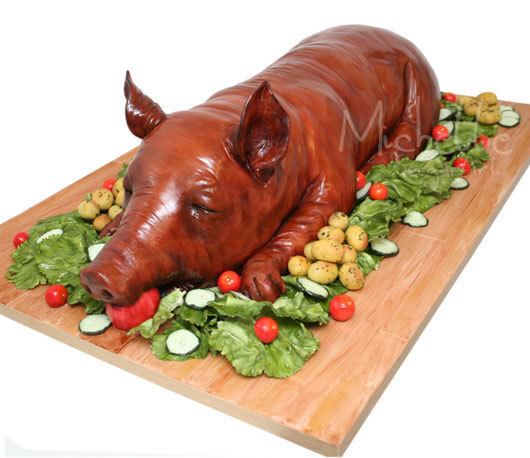
Lechón is a pork dish in several regions of the world, most specifically Spain and its former colonial possessions throughout the world. The word lechón originated from the Spanish term leche (milk), alluding to the immaturity of the piglet. Lechón is a popular cuisine in Spain, Cuba, Puerto Rico, Honduras, Argentina, Uruguay, Bolivia, Ecuador, Perú, Costa Rica, the Dominican Republic, other Spanish-speaking nations in Latin America. In Spanish cuisine, cochinillo asado is common used to refer to roast piglet, as lichen has drifted linguistically to mean any roasted pig. In most of these regions, lechón is prepared throughout the year for special occasions, during festivals, and the holidays.
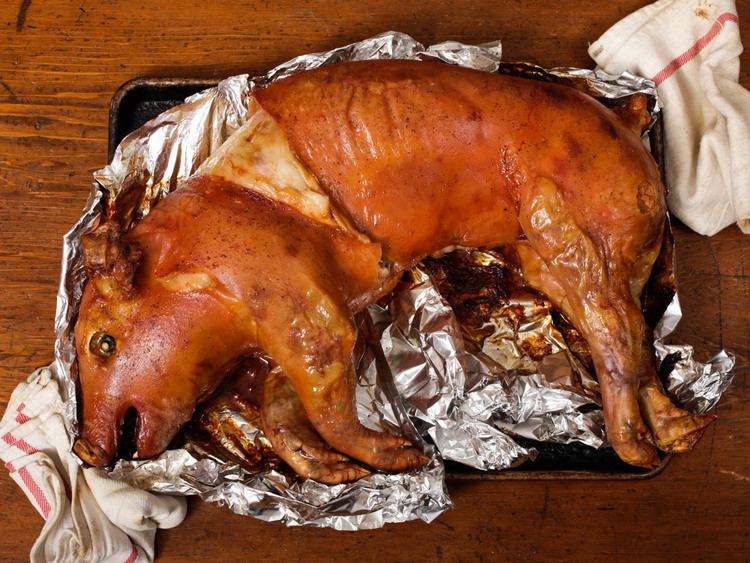
After seasoning, the piglet is cooked by skewering the entire animal, entrails removed, on a large stick and cooking it in a pit filled with charcoal. The piglet is placed over the charcoal, and the stick or rod it is attached to is turned in a rotisserie action.
Asia
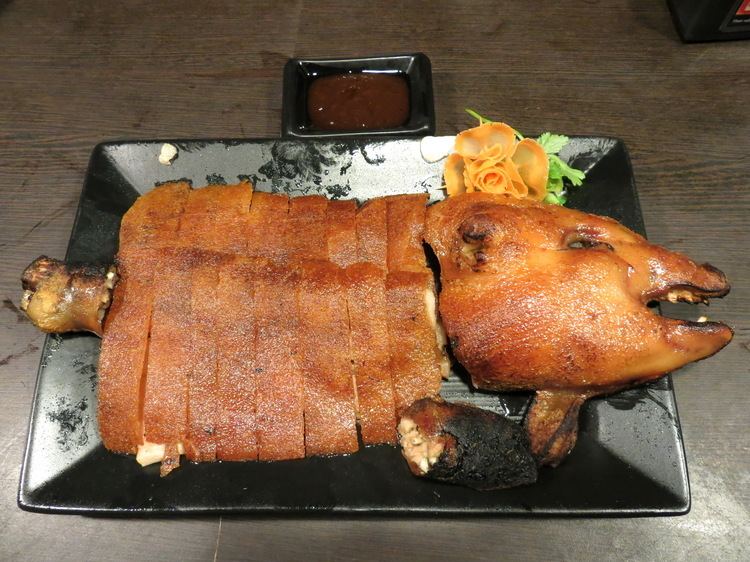
In Asia, roast suckling pig is eaten in Chinese or Vietnamese restaurants for important parties. It is also a popular dish at wedding dinners or a party for a baby's completion of its first month of life.
In the former Spanish colony of the Philippines, lechón (Filipino: litsón) is considered a national dish. As the usage of the term has evolved over the years, "lechón" has now come to refer to roasted pig in general (including suckling pigs). Suckling pigs in the country are referred to as lechón de leche, which corresponds to the term cochinillo in Spain.
There is also variant of Suckling Pork among the Indonesian non-Muslim ethnic groups, such as the Balinese, Batak, and Minahasa. Some pork dishes are also influenced by ethnic Chinese.
European
The European cuisines of Romania, Portugal (leitão), Spain, Germany, Austria, Albania, Croatia, and Georgia favor it highly as well. It also accompanies goose as the traditional Christmas feast of families in Russia and Serbia. Russian Navy maintains a tradition of presenting a roast piglet (or several) to the crew of a ship returning from deployment.
Suckling pig is known in German and Austrian cuisine as Spanferkel. It can be roasted in the oven or grilled, and is often served at festive occasions such as Oktoberfest.
United States
The suckling pig is used in Cajun cuisine in the southern U.S., where the Cochon de Lait festival is held annually in the small town of Mansura, Louisiana. During this festival, as its name implies, suckling pigs are roasted. Other uses for the suckling pig in the U.S. include slow roasting in an oven or (as in a Hawaiian-style pig roast) in a pit. The latter remains popular in the cuisine of the Southern United States.
